Britain has different cattle breeds that include both dairy and beef cattle. However, when walking across a farm in the countryside, you may notice cows but not recognize them.
Our detailed guide lists some of the typical British breeds of cattle. We also explain their characteristics and how to recognize them.
Table of Contents
14 British Breeds of Cattle
Below are some common breeds of cattle in Britain. The list also includes rare breeds that you may not often see around.
1. Aberdeen Angus
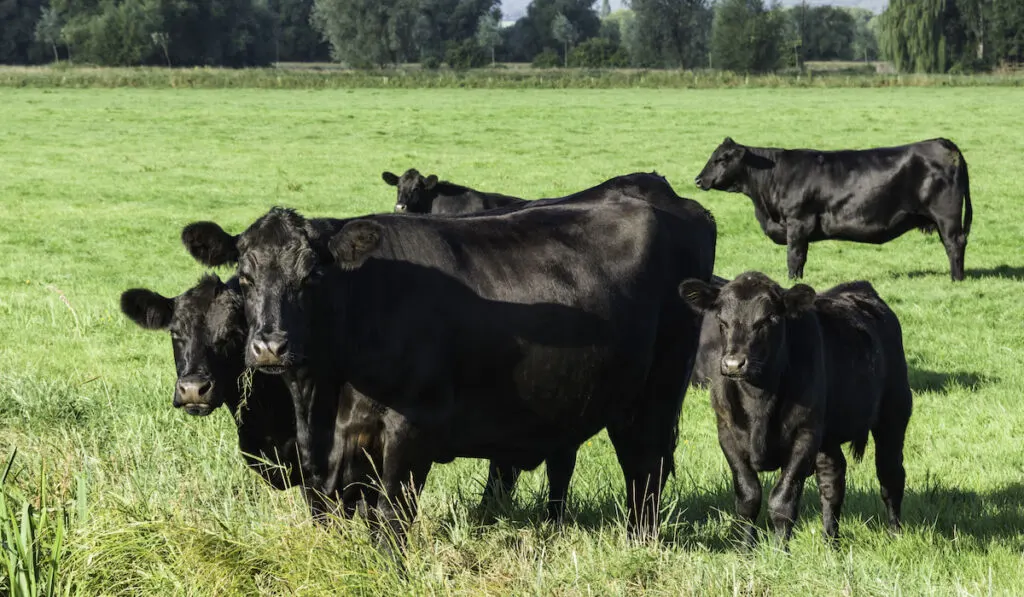
Aberdeen Angus is one of the rare cattle breeds in Britain. It’s believed that the breed was developed in the 19th century from polled black cattle of Scotland.
Early pioneers developed the Angus breed through line breeding and selection.
In the 20th century, Aberdeen cattle began spreading throughout Ireland, Scotland, and England. Although the breed is now rare, it’s still one of the best beef breeds of cattle.
Aberdeen Angus is predominantly black, but it’s possible to see some that are red. Their udder may have a white or black color.
The breed matures early, is adaptable to any weather, and is undemanding compared to other beef breeds. They also produce a high meat yield.
Farmers use Aberdeen Angus in crossbreeding to increase milking ability and carcass quality. The females have excellent calf-rearing abilities.
Another thing to note about this breed is that it’s naturally polled. That means it doesn’t require any dehorning as they have a natural polled gene.
The Angus breed is adaptable to all weather conditions and requires minimal maintenance.
2. Ayrshire
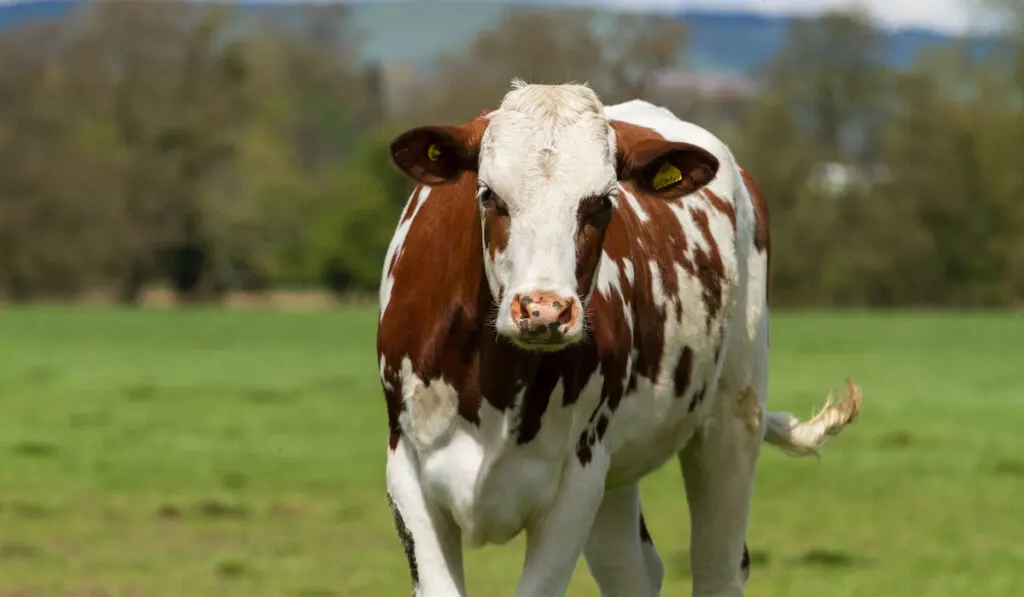
The Ayshire cattle breed is also from Scotland. Back in 1814, the Highland and Agricultural Society recognized it as a distinct breed.
It was later introduced in England in 1822 as the environment was similar to that of its native Scotland. The cattle have distinct patterns of white and shades of light red to dark brown.
The dairy cattle breed is medium-sized and has excellent milk production.
Most dairy farmers love Ayrshire for its simple calving, hardiness, and longevity.
You’ll find them adaptable to different farming methods due to their environment.
Additionally, the breed can survive with little feed unlike other dairy cattle breeds like the Friesian. Ayrshire cattle have a gentle temperament despite being the most dominant.
These cattle can produce over 20,000 lbs (9071 kg) of milk annually which contains about 4% fat. Their milk has evenly distributed, tiny fat globules which make it ideal for producing dairy products and treats such as yogurts, cheeses, and ice cream.
3. Belted Galloway
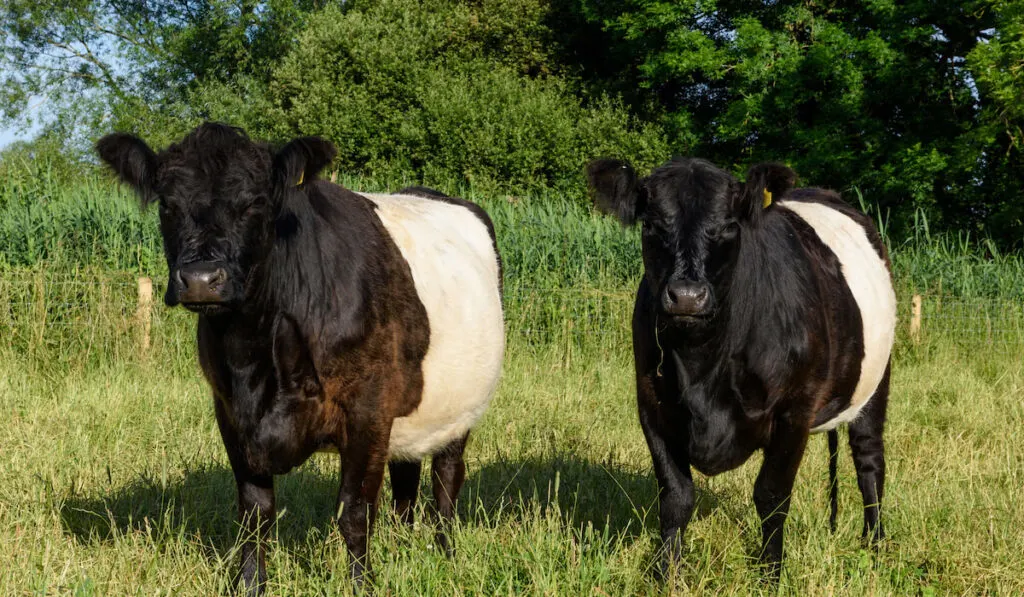
The Belted Galloway is one of the easy-to-recognize breeds due to its unique appearance. It’s mainly raised for its meat.
Originally from Southwest Scotland, the breed was later introduced in England. It adapts quickly to any climate.
The breed is predominantly black, with a white ring section encircling the body. It can also have a red or dun body depending on its origin.
Most farmers rear the Belted Galloway for its uniquely flavored beef with a soft texture. Its meat has a fat content of about 2%, which is extremely low. These cattle also produce a lot of rich milk.
It also has a soft undercoat for warmth and a double coat of long hair that sheds off the rain.
The Belted Galloway is naturally polled, so you won’t have to deal with horns. They can be crossed with another breed to prevent the growth of horns.
These cattle can adapt to various climates and are excellent foragers. Their ability to survive in any condition makes them resistant to diseases like pink eye and foot problems.
4. British White
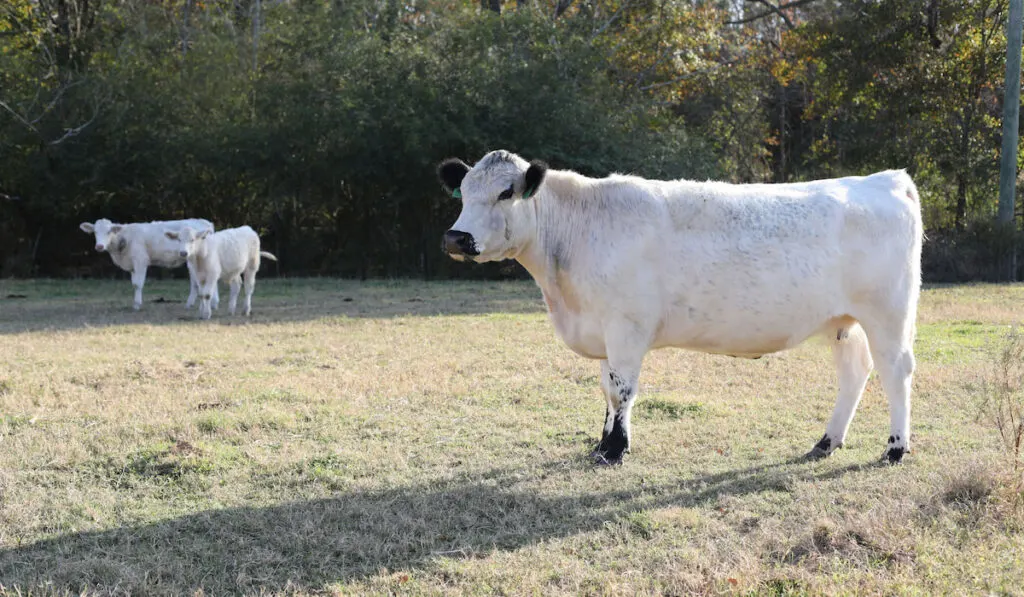
The British White cattle breed was initially developed in 1765 in Gunton Park. It was developed by breeding a polled bull from Cleveland (in northeast England).
It’s one of the polled breeds that’s reared for its beef.
The cattle are white with black points on the ears, nose, muzzle, eyelids, tongue, and hooves. The black points’ pigmentation reduces the problem of sunburn and eye cancer.
The breed is also docile and hardy.
British White cattle are good milk producers. They are also famous for their quality beef with a soft texture.
The breed also has excellent mothering abilities. The females also create nurseries to protect groups of calves as other herd members graze.
5. Blue Grey
The Blue Grey breed is a cross between the rare Whitebred Shorthorn and the Galloway.
Similar to most breeds in Britain, the Blue Grey is from the highlands of Scotland and North Yorkshire.
The breed has auburn mottled hair or a Rooney Blue-grey, which gives it a distinctive look.
Their color doesn’t breed true because roan is due to an incomplete dominance between a solid and white color.
It’s also a polled breed, known mainly for its slow-grown, high-quality beef. Blue Grey cattle take up to three years to reach their slaughter weight.
Blue Grey cattle are excellent foragers and will eat coarse and rough grass that other breeds will avoid. They are also easier to maintain, although they take a long time to reach maturity.
6. Dexter
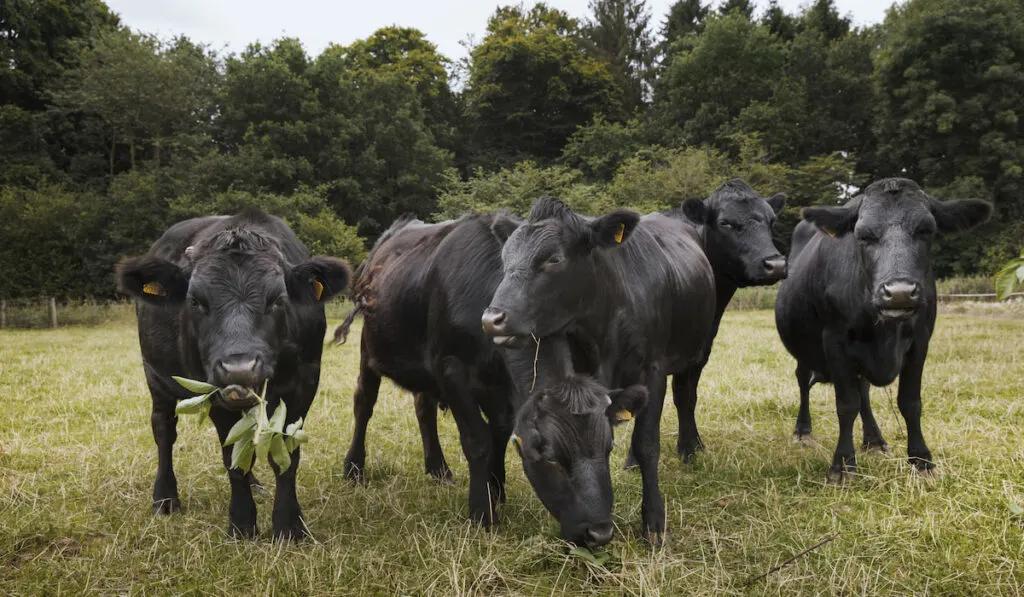
Dexter is another common British breed of cattle.
It’s believed to be from Southern Ireland and a cross between the Kerry and Davon. The cross was to help improve beef quality and give it a smaller size.
Mr. Dexter, the man responsible for the Irish breed, promoted the cattle to small-scale farmers in England as a multipurpose breed. They could produce both beef and milk in a smaller area.
These cattle are some of the smallest, standing at 40 in. Dexters are primarily black, although some can be dun and red. They are also horned.
The quantity of beef or milk produced will vary between strains. Dexter beef is high quality and lean, while its milk is high in solids, which is excellent for cheese and butter production.
Dexters are good grazers and can also work as oxen. They are also maternal, and calving problems are minimal.
7. Gloucester

The Gloucester cattle breed is named after Gloucestershire, England. It’s a rare breed in Britain reared for its milk and beef production.
The breed has a black, brownish color. Its back, belly, and tail have a white streak, and its hair is short and fine. Gloucester breed is horned with black tips that turn upwards.
It’s also one of the slow-maturing breeds. While this may be a shortcoming for a farmer rearing it for profit, the cattle produce some of the best marbled and fine-grained beef.
Gloucesters also make rich milk, which is why single and double Gloucester cheese is common. The bulls can also work as oxen for draught purposes.
8. Guernsey

The Guernsey cattle has its origins on the British Channel Island of Guernsey. History shows that the breed was developed as a cross between the Isigny cattle and Froment du Leon.
It’s one of the well-established breeds in Britain known for its quality milk production.
You can recognize this breed easily as it has a reddish-brown color and white patches. Guernseys are not irritable. Their temperament is calm and finely tuned.
A mature bull weighs close to 1,543 lbs(700 kg), while a cow weighs up to 1,102 lbs (500 kg).
The breed also converts feed to product efficiently, which translates to high-quality milk.
Research shows that Guernseys have a B-casein gene that gives cheese increased volume and a firmer curd.
They quickly adapt to all climates and don’t have limiting genetic recessiveness.
9. Hereford
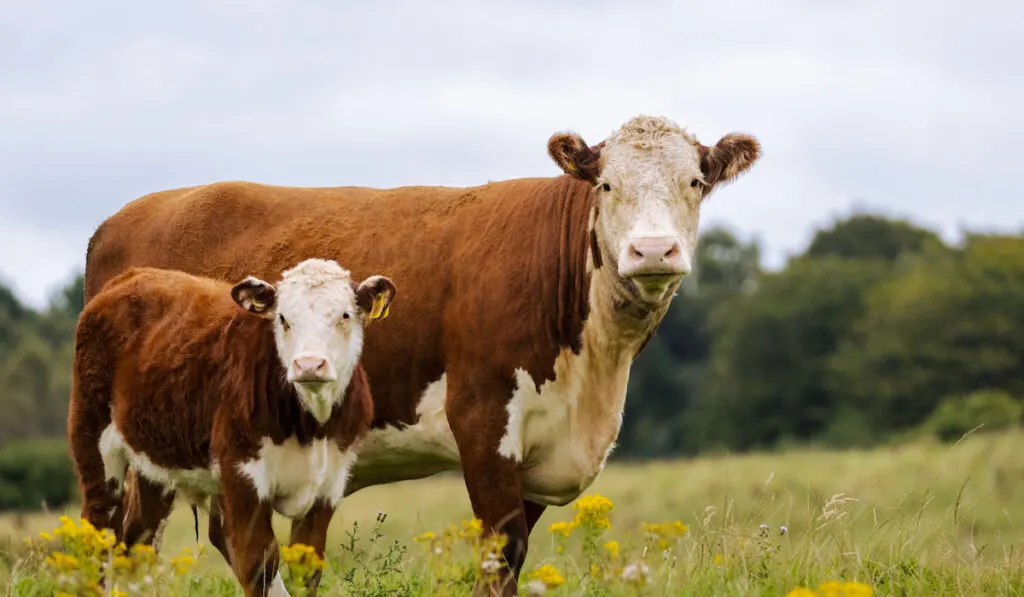
The Hereford cattle breed is originally from the border of Wales and England. The breed is named after the county Herefordshire, a renowned agricultural region.
It was reared as a beef-producing breed, and up to today, Herefords produce quality, high-yield beef compared to other beef breeds.
The cattle have a red-yellow color with a white underline, crest, dewlap, and face. Most have thick and short horns curved down at the sides, although you can find polled Hereford in Britain.
They are also prominent in size and well developed at the loin, back, and hind quarters.
Hereford cattle can adapt to any climate, and they mature early. Furthermore, they are docile and easy to manage.
10. Highland
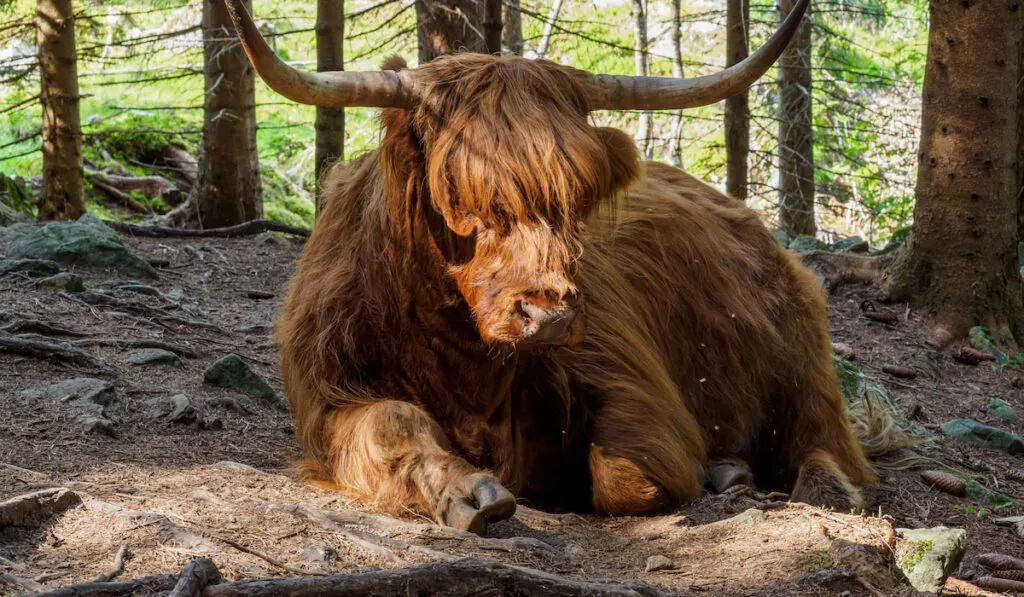
The Highland breed of cattle is from the Scottish Highlands. Famous for being tough and hardy, they are known to be resistant to cold.
This breed is also referred to as Long-haired Scottish cattle or Long-haired Highland cattle.
Highland cattle have wavy, long, woolly coats that can be dun or black. Their double coat keeps them warm during the cold season.
The breed also has long horns that help them forage and find other materials under the snow.
These cattle are reared for their meat. The beef is juicy and flavorful. They are also kept as ornamental animals because of their unique appearance.
Unlike most big breeds, Highland cattle are smaller and perfect for small-scale farming. They don’t require a lot of space and grazing land to thrive.
This breed is also hardy, which allows them to survive in any environment.
On average, Highland cattle have a life expectancy of up to 20 years.
11. Irish Moiled

The Irish Moiled is a rare cattle breed reared for its milk and beef. It’s one of the breeds that originated in Ireland.
Characterized by a red color marked with a white “finching” on the underside and back, the Irish Moiled are medium-sized, with a mature cow weighing up to 1,323 lbs (600 kg).
They are also docile and easy to handle. The dual-purpose breed is an excellent forager and can survive on an inadequate diet.
Irish Moiled cattle are also ready browsers of ivy and willow, making them great for conservation.
Although the breed was traditionally a dairy cow, it has, over time, become famous as a dual-purpose breed.
When keeping the pedigree breed, you should note that it takes time to mature, unlike most breeds. However, that also contributes to the rich and succulent flavour of the beef.
12. Jersey
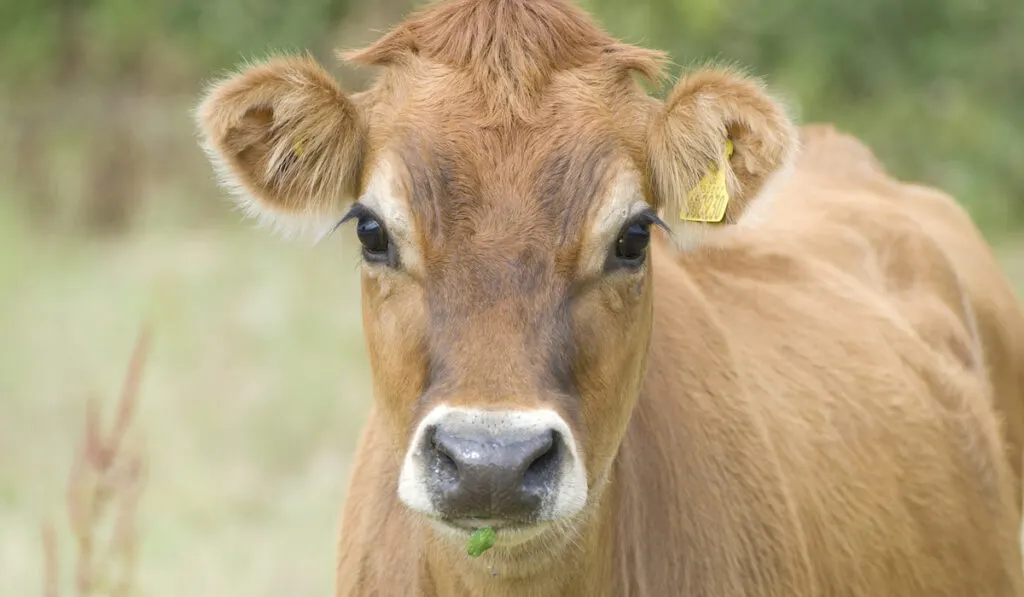
Jersey cattle were initially from the Channel island of Jersey. The breed is relatively small compared to most dairy cattle breeds.
These cattle have a shade of cream or fawn, but you can find some with a darker shade. Their udders are large, and they have black tails. Jerseys have small and curved horns.
A mature bull weighs 1,808 lbs (820 kg), while a cow can weigh up to 1,102 lbs (500 kg).
Jersey cattle are known to be superior grazers, and their calm demeanor makes them friendly to other livestock on the farm. The breed is easy to calve.
As one of the highly sought-after milk breeds, Jerseys produce more high-fat milk than average milk. Their milk has the highest yield and efficacy when processed into cheese and other milk products.
Jerseys have a high feed conversion efficiency and can thrive in varied conditions.
13. English Longhorn

The English Longhorn has its origins in England’s northern counties. Although the breed was reared for beef and milk, it’s now mainly kept for its meat.
English Longhorns have brown, gray, or red coats and long horns curved towards their nose.
They are also medium-sized, with bulls weighing close to 2,204 lbs (1000 kg) and cows up to 1,300 lbs (590 kg) when mature.
The breed is also friendly, and their docile nature makes them easier to manage. Longhorns are also excellent foragers and tend to keep to their enclosed space.
Small-scale farmers will love keeping this breed as they don’t need much grazing land and get along with other livestock.
14. Lincoln Red
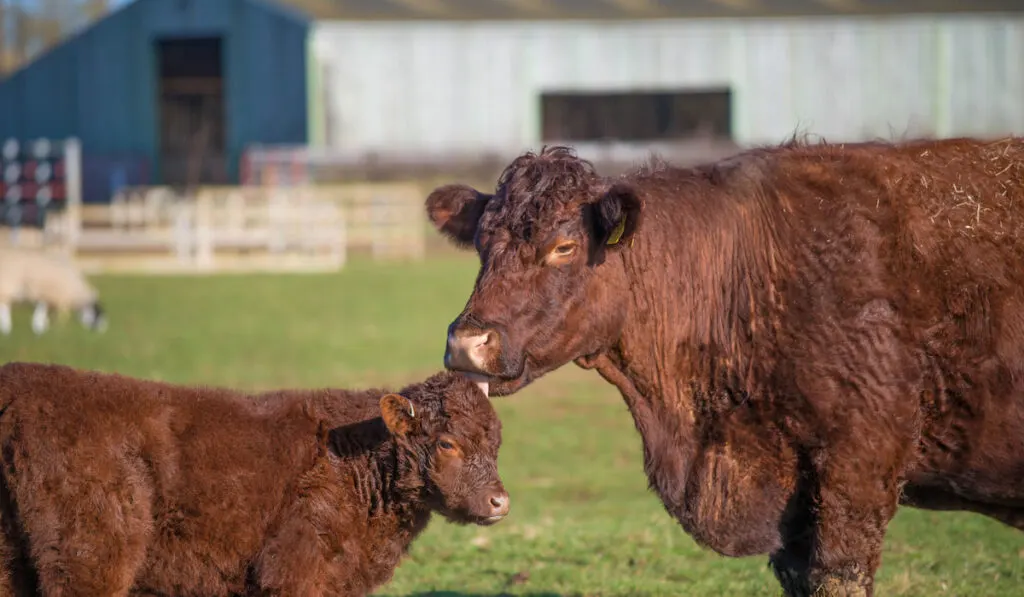
The Lincoln Red dates back to the 1700s and is considered one of the oldest native breeds in Britain.
These cattle have a uniform dark red color on their body. Most of them are polled and have broad muzzles and foreheads.
Although Lincoln Red was previously kept as a dual-purpose breed, more farmers are opting to keep it as a beef cattle breed.
Lincoln Reds are hardy and need little care. A calm temperament and a docile nature are some other characteristics you’ll find in this breed.
They also mature earlier and can survive in cold climates. Farmers considering small-scale beef production will find this breed an excellent option.
Finally
Our list covers some of the most common and rare cattle breeds with British origins.
Although some breeds are rare, various breeders and conservation groups work hard to ensure they are preserved for future generations.
Resources
- https://genetic.by/en/the-aberdeen-angus-cows-description-and-characteristics-of-the-breed
- http://afs.okstate.edu/breeds/cattle/britishwhite/index.html/
- https://britishwhite.org/
- https://www.southormsbyestate.co.uk/estate/nature/lincoln-red-cattle/
- https://www.dextercattle.co.uk/the-breed/why-dexters/
- http://www.gloucestercattle.org.uk/
- https://guernseycattle.com/about/breed-facts/
- https://www.thecattlesite.com/breeds/beef/14/hereford/
- https://www.thecattlesite.com/breeds/beef/40/highland/
- https://www.irishmoiledcattlesociety.com/the-breed/
- https://www.thecattlesite.com/breeds/dairy/23/jersey/
- http://afs.okstate.edu/breeds/cattle/jersey/index.html/
- https://www.thecattlesite.com/breeds/beef/61/english-longhorn
- https://www.highlandcattlesociety.com/why-highlands
- https://www.macduffbeef.co.uk/breeds/blue-grey/
- https://www.slowfood.org.uk/ff-products/blue-grey-cattle/
- https://www.thecattlesite.com/breeds/beef/9/belted-galloway
- https://www.thecattlesite.com/breeds/dairy/19/ayrshire
